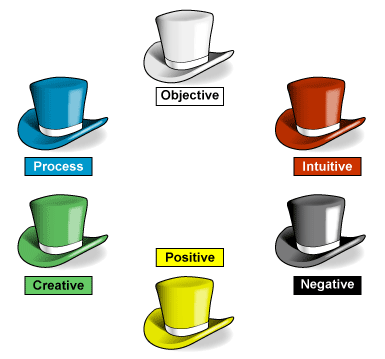Thinking with Hats
This post originally appeared on August 25, 2010 on BetterProjects.net.
 I have seen every brainstorming and idea generation method under the sun… or at least that’s what I had thought until a meeting with my company’s R&D team a few weeks back. The subject of the meeting itself isn’t important to this post, but the method we used most certainly is. This method is not new, even though it was new to me, and presented an interesting take on the managing of a brainstorming session. Without further adieu, I give you Edward de Bono’s Six Thinking Hats.
I have seen every brainstorming and idea generation method under the sun… or at least that’s what I had thought until a meeting with my company’s R&D team a few weeks back. The subject of the meeting itself isn’t important to this post, but the method we used most certainly is. This method is not new, even though it was new to me, and presented an interesting take on the managing of a brainstorming session. Without further adieu, I give you Edward de Bono’s Six Thinking Hats.The Method Behind the Madness
Nothing in this methodology is amazingly new or surprisingly different. It follows the standard steps of framing a problem or opportunity, working up ideas to solve it or meet the need, poking holes in the solutions and then finding ways to plug the leaks you just created. What I did find of interest is the way the methodology forces a group to work through the process in a structured manner but doesn’t necessarily stifle any creative inputs.
The basic idea is that the human brain thinks in very specific ‘modes’, or as de Bono would say, hats. Each hat is represented by a color and has a different meaning and function. Its not necessary to give everyone in the room 6 different colored physical hats to wear during the corresponding session, but its more of a way to keep everyone in the session focused on the goals of that particular hat. (For a great explanation of each hat color, see this Wikipedia article.)
The purpose of the session determines which hats get used, which get used more than once and in what order the hats are used. Idea generation, problem solving, strategic planning… there are many ways to combine the hats to reach a desired outcome.
The Good Stuff
One of the things I really like about this method is its structure. If you’ve ever been involved in a brainstorming session that ended up on a topic totally unrelated to the stated reason for the session, you understand the reason a methodology like de Bono’s is needed.
Similarly, if you’re in charge of a meeting with a large number of stakeholders who are easily distracted, disruptive or simply uncontrollable, using a structured methodology like this can improve the results of the session. Getting such a group to agree to adhere to the tennets of the process may prove difficult, but if they can buy in to it, you’re that much closer to a successful conclusion.
The (Potential) Bad Stuff
Overly structuring a session can lead to a few negative consequences as well. While the six thinking hats are not an extremely rigid methodology, for a group that is comfortable with one another and already works well together, adding in a more formal set of guidelines such as these may temporarily derail output as people adjust to the new discussion norms.
Another potential downside is a stifling of creativity due to having an overly zealous 'traffic cop’ who righteously knocks down any comments that don’t pertain to the current 'hat’ that is being worn by the team. Its one thing to keep a group on track, but the moderator must focus on reaching an objective more than just adhering to a given method.
Have you used the six thinking hats before? If so, let us know how it went down in the comments section. If you haven’t used it, do you see how it might be useful in your organization?
